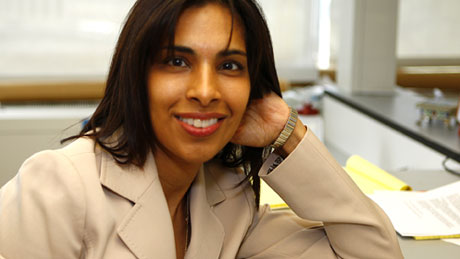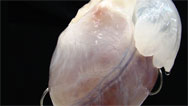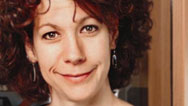
Profile: Sangeeta Bhatia
Intrigued by the idea of artificial organs, a biomedical engineer uses computer-chip technology to craft tiny livers. Airing July 21, 2009 at 9 pm on PBS Aired July 21, 2009 on PBS

Program Description
Transcript
Profile: Sangeeta Bhatia
PBS Airdate: July 21, 2009
NEIL DeGRASSE TYSON: Sometimes, if something goes terribly wrong with one of your organs—let's say your liver stops working—surgeons might be able to replace it and help you survive.
But for this kind of transplant to work, you need a new liver standing by, one that somebody just donated. Internal organs like this have no shelf-life and they're hard to find. But what if we could manufacture livers, so that you could just order up a new one if you needed it?
Well, in this episode's profile, we meet a bioengineer who's trying to do just that, by figuring out how to build functioning livers in the lab, on demand.
SANGEETA BHATIA: I don't cook at all. My husband likes to say that I'm very good at "preparing" things, which means, like, heating them up. I don't keep my car very clean; my car is a mess. Right now, it smells like a dead animal.
NEIL DeGRASSE TYSON: Sangeeta Bhatia seems a lot like the rest of us.
ALICE CHEN (PhD student, Harvard-MIT): She actually is really normal.
GEOFFREY VON MALTZAHN (PhD student, Harvard-MIT): I think she's remarkably normal.
MEHMET TONER (Sangeeta Bhatia's Ph.D. Advisor): I find Sangeeta is a very normal person.
SANGEETA BHATIA: I'd like it to be that if you met me socially, you wouldn't necessarily know what I did, until I told you.
NEIL DeGRASSE TYSON: What this M.I.T. doctor and bioengineer has done isn't exactly normal. She was a pioneer in getting liver cells to function outside the human body, taking a major step toward developing an artificial liver.
Her problem-solving potential became obvious at an early age, when she performed surgery on the family's broken answering machine.
SANGEETA BHATIA: I got out the screwdriver, and took it apart, and laid all the pieces on the table, and tried to figure out what was broken. And I found something that looked amiss and fixed it. And lo and behold, the answering machine worked again. There were actually some parts left over that were supposed to belong on the inside, but it was working anyway, so I called it a day.
NEIL DeGRASSE TYSON: Sangeeta's parents emigrated from India, her father, an engineer, and her mother, one of the first female M.B.A.s in India.
SANGEETA BHATIA: My mom was, sort of, ahead of her time. She was a really independent, strong woman. If I look back on it now, she arranged her life so that she could work and contribute and still be home for us when we came home from classes.
When I was in high school, I, even like now, had a very full life. So I've always had a lot of things going on. I had a lot of really hard classes, I was twirling baton, I was dancing. I think I never really thought about the fact that it was a lot of work. I just thought about how I could do all the things I wanted to do.
NEIL DeGRASSE TYSON: And all these activities helped her to deal with the stresses of schoolwork.
SANGEETA BHATIA: You can't worry about the exam that's the next day, because you're focusing, in the moment, on learning this move. And I think what emerged from it was this, this, probably, more balanced version of me.
NEIL DeGRASSE TYSON: But after arriving at M.I.T., the harsh reality of a highly competitive, around-the-clock-work culture hit hard.
SANGEETA BHATIA: I felt, in the beginning, really out of my league, like I could never possibly work enough hours in the day. And I came to the lab one Saturday night at 3 a.m., and I noticed the lab was full of people. And I had this moment where I realized that I didn't want to be there every Saturday night at three in the morning.
Science is a marathon, and finding ways to protect part of yourself is an important part of success in the marathon.
NEIL DeGRASSE TYSON: In Sangeeta's marathon, she got a Ph.D. in biomedical engineering from M.I.T. and an M.D. from Harvard. And in the process, she applied the power of computer chip technology to tackle one of the human body's most complicated organs.
SANGEETA BHATIA: I fell in love with the liver, sort of by accident. When I was a first-year graduate student, my advisor, Mehmet Toner, had what seemed like this fascinating project, which was to make an artificial liver. It would be an off-the-shelf transplant that you could give a patient, that didn't have to come from another dying patient.
NEIL DeGRASSE TYSON: The first step toward making this artificial liver was to take liver cells from a real liver, and get them to function outside the human body, in the lab. The problem was, as soon as the liver cells were removed from the body, they immediately began to die.
MEHMET TONER: As soon as we take liver cells out of the body, put it in a laboratory environment, all bets are off. They don't function, they are not happy. And Sangeeta's problem was to tackle that.
NEIL DeGRASSE TYSON: She saw that inside the body, the liver cells branched off into stripes. Since cells communicate with one other through chemical signals, this striped pattern could be crucial.
SANGEETA BHATIA: The hypothesis was tissue architecture should matter, but no one had ever done the experiment to show that that was the case.
NEIL DeGRASSE TYSON: The challenge now was to get the tiny liver cells to obediently line up on a slide, in the lab, exactly as they do in the human body.
Combining her backgrounds in biology and engineering, Sangeeta turned to the technology used in producing the tiny patterns on computer chips.
SANGEETA BHATIA: If you've ever seen a picture of a computer chip, and it has all these networks of wires that make circuits—that technology that makes those patterns works by shining light on a surface.
NEIL DeGRASSE TYSON: Using the same technique, creating a chemical reaction with light to etch striped lines onto glass slides, she hoped to corral the liver cells into formation.
SANGEETA BHATIA: For about a year I tried this. Turned out, for my liver cells, nothing actually worked. At one point in the process, I started to think I was losing my mind, because the experiment was, you take this piece of glass that's clear, and you shine light on it, and it's still clear. And you dip it in a bunch of clear solutions, and you pour cells on it, and at the end they're supposed to organize. After you do this about a thousand times, and you never see organized cells, you start to the think that you're insane.
NEIL DeGRASSE TYSON: After laboring over her experiment for a year, one day, everything changed.
SANGEETA BHATIA: The moment that I looked into the microscope and saw the...that this thing that I had invented in my head had actually come to fruition was amazing.
NEIL DeGRASSE TYSON: With the cells lined up properly, their communication system was working. Not only were the micro-livers functioning, they were now living for an unprecedented six weeks, outside of the human body.
MEHMET TONER: It enhanced our understanding of liver biology significantly. She figured out that if you put liver cells on a surface in a certain, specific geometric configuration, bingo! Liver cells start functioning.
NEIL DeGRASSE TYSON: Soon, these micro-livers could be used to test experimental vaccines for malaria. And Sangeeta hopes that within her lifetime, she can create a functioning, artificial liver, to save patients with liver failure. But to do this, she needs a lot of help.
SANGEETA BHATIA: I have a ton of support. I have a babysitter at home, an assistant at work, and somebody who helps run the lab, and a husband that's supportive and parents that are nearby. So, it sort of takes a village to help me run my life.
NEIL DeGRASSE TYSON: It's this team of people that gives her more time to spend with her two daughters. And she makes certain that her daughters have the same kind of positive role models that she had growing up.
And in her family, Barbie(TM) is not one of them.
JAGESH SHAH (Sangeeta Bhatia's Husband): Barbie is kind of persona non grata in our house.
SANGEETA BHATIA: Barbie, in our house, is "that doll that Mommy doesn't like." Barbie really represents the exaggerated figure, the "I don't like math." And so, when I had girls, I really didn't want Barbies in the house. I didn't want that body image, I didn't want that focus on materialism—I just didn't, you know, like anything about Barbie.
NEIL DeGRASSE TYSON: Instead, she gave her daughters a Marie Curie doll.
SANGEETA BHATIA: The cool thing about Marie Curie is that she was, of course, the first Nobel Prize-winning woman. She was also the mother of two little girls. And her older daughter went on to win the Nobel Prize herself.
JAGESH SHAH: Oh, my goodness, that went down really fast.
SANGEETA BHATIA: Right to the bottom. Which one is denser?
SANGEETA BHATIA'S DAUGHTER: What does "denser" mean?
SANGEETA BHATIA: I don't think that science is necessarily a career for everyone. I want to share with them a curiosity for the way the world works, and I think whatever they want to be, they should be.
JAGESH SHAH: What's happening now?
SANGEETA BHATIA'S DAUGHTER: It's getting sparkly.
NEIL DeGRASSE TYSON: And it's not just her own daughters that she wants to inspire.
SANGEETA BHATIA: Keys to Empowering Youth was an outreach organization that I helped to start when I was in graduate school.
ALICE CHEN: We see these young girls come in and get so excited to put on lab coats and lab goggles and work with the equipment. And I think that it does make them think about choosing science and engineering as a career, and at least shows them that they have that option.
GEOFFREY VON MALTZAHN: I think Sangeeta is a wonderful role model for women, but she's a terrific role model for anybody. One of the hardest things in life is to make a clear distinction between how much time you're going to dedicate to your work, and how much time you're going to dedicate to your family and your friends. And she is able to manage both of those with a sense of ease that I think is inspirational, independent of whether you're a man or a woman.
ALICE CHEN: Once, when I was at Sangeeta's house, I was sitting with her at her dining room table, and I said, "Wow, this is place is lovely. I can imagine you working here." And she said, "Why? I don't work all the time at home. I have a life. I have my kids." I think that she just always reminds us that life is more than just work.
SANGEETA BHATIA: It is a lot of work to be a mom, and it is a lot of work to run a lab, but I don't really think about the fact that it's a lot of work; I just try and figure out how to make them all fit together.
On Screen Text: Remember Fantastic Voyage? Scientists miniaturized a submarine so that it could be injected into a patient, so they could perform surgery from the inside. Sangeeta's working on a way to perform surgery on a similar scale from the inside, as well.
By injecting tiny particles that bind to cancer cells, doctors may one day be able to image cancer cells, deliver drug therapies, and kill cancer cells, all without invasive surgery.
Downside? No Fantastic Voyage for Sangeeta.
Broadcast Credits
Profile: Sangeeta Bhatia
- Edited by
- Jedd Ehrmann
- Written, Produced and Directed by
- Terri Randall
NOVA scienceNOW
- Executive Producer
- Samuel Fine
- Executive Editor
- Neil deGrasse Tyson
- Senior Series Producer
- Vincent Liota
- Senior Producer
- Julia Cort
- Supervising Producers
- Stephen Sweigart
Joey David Jovanovich - Senior Editor and Colorist
- David Chmura
- Online Editor
- Laura Raimondo
- Senior Researcher
- Sharon Kay
- Associate Producer
- Fran Laks
- Assistant Editors
- Rob Chapman
Tung-Jen (Sunny) Chiang - Graphic Design
- Brian Edgerton
- Compositor & Animator
- Yunsik Noh
- Music
- Rob Morsberger
- Sound Mix
- Bill Cavanaugh, RazorMix, Inc.
- Assistant to Neil deGrasse Tyson
- Elizabeth Stachow
- NOVA scienceNOW Series Animation
- Edgeworx
- Field Producer for Sea Lions segment
- Solana Pyne
- Associate Producers
- Heeth Grantham
Jeff Marion
Laura Willcox - Camera
- Steve Baum
Joe Brunette
Austin de Besche
Dan Krauss
Jon Shenk - Sound Recordists
- Fred Burnham
Jim Choi
Michael Cottrell
Doug Dunderdale
Charlie Macarone
Claudio Musajo - Animation
- Anthony Kraus
399 Productions - Production Manager for Picky Eaters segment
- Michael Reichman
- For Lone Wolf Documentary Group
-
- Executive Producer
- Kirk Wolfinger
- Production Manager
- Donna Huttemann
- Archival Material
- Corbis
Wiley-VCH. Small 2009, pp. 694-700 - Special Thanks
- Bright Horizons Family Solutions
Phil Darrell
John Glendinning
Christopher Graves
Icelandic Tourist Board
Liz Jones
Sue Kangiser
Maryam M. Khani
Sam Krevor
Kristy Lindemann-Biolsi
Microsystems Technology Laboratory at MIT
Petqua
Peter Renee
Jagesh Shah
South Mountain YMCA Child Care Center
StatoilHydro
Leslie J. Stein
Scott Stein and the Springside School
Tucson 12
Jennifer Wade
Hans Ziock - Neil deGrasse Tyson
- is director of the Hayden Planetarium in the Rose Center for Earth and Space at the American Museum of Natural History.
- NOVA Series Graphics
- yU + co.
- NOVA Theme Music
- Walter Werzowa
John Luker
Musikvergnuegen, Inc. - Additional NOVA Theme Music
- Ray Loring
Rob Morsberger - Post Production Online Editor
- Spencer Gentry
- Closed Captioning
- The Caption Center
- NOVA Administrator
- Mykim Dang
- Publicity
- Carole McFall
Eileen Campion
Victoria Louie
Karinna Sjo-Gaber
Karen Laverty - Marketing
- Steve Sears
- Researcher
- Kate Becker
- Senior Researcher
- Gaia Remerowski
- Production Coordinator
- Linda Callahan
- Paralegal
- Sarah Erlandson
- Talent Relations
- Scott Kardel, Esq.
Janice Flood - Legal Counsel
- Susan Rosen
- Production Assistant
- Ryan Murdock
- Post Production Assistant
- Darcy Forlenza
- Associate Producer, Post Production
- Patrick Carey
- Post Production Supervisor
- Regina O'Toole
- Post Production Editors
- Rebecca Nieto
Jason York - Post Production Manager
- Nathan Gunner
- Compliance Manager
- Linzy Emery
- Development Producer
- Pamela Rosenstein
- Business Manager
- Joseph P. Tracy
- Senior Producer and Project Director
- Lisa Mirowitz
- Coordinating Producer
- Laurie Cahalane
- Senior Science Editor
- Evan Hadingham
- Senior Series Producer
- Melanie Wallace
- Managing Director
- Alan Ritsko
- Senior Executive Producer
- Paula S. Apsell
This material is based upon work supported by the National Science Foundation under Grant No. 0638931. Any opinions, findings, and conclusions or recommendations expressed in this material are those of the author(s) and do not necessarily reflect the views of the National Science Foundation.
NOVA scienceNOW is a trademark of the WGBH Educational Foundation
NOVA scienceNOW is produced for WGBH/Boston by NOVA
© 2009 WGBH Educational Foundation
All rights reserved
- Image credit: (Sangeeta Bhatia) Robert E. Klein/AP, ©HHMI
Participants
- Sangeeta Bhatia
- hst.mit.edu/public/people/faculty/facultyBiosketch.jsp?key=Bhatia
- Alice Chen
- PhD student, Harvard-MIT
- Jagesh Shah
- Sangeeta's husband hst.mit.edu/public/people/faculty/facultyBiosketch.jsp?key=Shah
- Mehmet Toner
- Sangeeta's PhD advisor hst.mit.edu/public/people/faculty/facultyBiosketch.jsp?key=Toner
- Geoffrey Von Maltzahn
- PhD student, Harvard-MIT
Preview
Full Program | 11:17
Full program available for streaming through
Watch Online
Full program available
Soon









